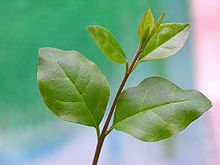| Revision as of 06:57, 22 August 2019 editJérôme (talk | contribs)Extended confirmed users3,602 edits subsections← Previous edit | Revision as of 07:18, 15 December 2019 edit undoUpdateNerd (talk | contribs)Extended confirmed users36,132 edits →Description: poisonous fruitNext edit → | ||
| Line 11: | Line 11: | ||
| == Description == | == Description == | ||
| ''Ligustrum sinense'' is a ] ] growing to 2–7 m tall, with densely hairy shoots. The leaves are opposite, 2–7 cm long and 1–3 cm broad, rarely larger, with an entire margin and a 2–8 mm ]. The flowers are white, with a four-lobed ] 3.5–5.5 mm long. The fruit is ], 5–8 mm diameter |
''Ligustrum sinense'' is a ] ] growing to 2–7 m tall, with densely hairy shoots. The leaves are opposite, 2–7 cm long and 1–3 cm broad, rarely larger, with an entire margin and a 2–8 mm ]. The flowers are white, with a four-lobed ] 3.5–5.5 mm long. The fruit is ], 5–8 mm diameter,<ref name=foc/><ref></ref> and considered poisonous.<ref>{{cite book|last=Little|first=Elbert L.|title=The Audubon Society Field Guide to North American Trees: Eastern Region|publisher=Knopf|location=New York|year=1980|isbn=0-394-50760-6|p=655}}</ref> | ||
| == Varieties == | == Varieties == | ||
Revision as of 07:18, 15 December 2019
Species of plant
| Chinese privet | |
|---|---|

| |
| Scientific classification | |
| Kingdom: | Plantae |
| Clade: | Tracheophytes |
| Clade: | Angiosperms |
| Clade: | Eudicots |
| Clade: | Asterids |
| Order: | Lamiales |
| Family: | Oleaceae |
| Genus: | Ligustrum |
| Species: | L. sinense |
| Binomial name | |
| Ligustrum sinense Lour. | |
Ligustrum sinense (Chinese privet; syn. L. villosum; in Mandarin: 杻; pinyin: chǒu) is a species of privet native to China, Taiwan and Vietnam. It is also naturalized in Réunion, the Andaman Islands, Norfolk Island, Costa Rica, Honduras, Panamá and much of the eastern and southern United States (from Texas and Florida north to Kansas, Illinois, New Jersey, Massachusetts and Connecticut). Ligustrum lucidum is sometimes also called "Chinese privet".
Description
Ligustrum sinense is a deciduous shrub growing to 2–7 m tall, with densely hairy shoots. The leaves are opposite, 2–7 cm long and 1–3 cm broad, rarely larger, with an entire margin and a 2–8 mm petiole. The flowers are white, with a four-lobed corolla 3.5–5.5 mm long. The fruit is subglobose, 5–8 mm diameter, and considered poisonous.
Varieties
The following varieties are accepted by the Flora of China:
- Ligustrum sinense var. sinense
- Ligustrum sinense var. concavum M.C.Chang
- Ligustrum sinense var. coryanum (W.W.Sm.) Hand.-Mazz.
- Ligustrum sinense var. dissimile S.J.Hao
- Ligustrum sinense var. luodianense M.C.Chang
- Ligustrum sinense var. myrianthum (Diels) Hoefker
- Ligustrum sinense var. opienense Y.C.Yang
- Ligustrum sinense var. rugosulum (W.W.Sm.) M.C.Chang
Cultivation and uses

It is cultivated as an ornamental plant and for hedges. Several cultivars have been selected, including the very floriferous 'Multiflorum', the variegated cultivar 'Variegatum', and the dwarf cultivar 'Wimbei' growing to 0.5 m and with leaves only 6 mm long.
Chinese privet, under the commercial name "white wax wood", is a prized material for spears and darts among Chinese martial artists. It has also been held in high esteem as an arrow wood by archers in North America, because its shoots are often quite straight, the wood is very flexible, springy and tough, and in many states abundant.
Chinese privet wood has poor rot resistance in its natural state, but burnishing its surface with another piece of wood, or with privet wood shavings, produces a unique "waxy" polish that is pleasing to the eye, and significantly improves rot resistance.
It has also been used as a popular bonsai tree.
It was introduced to North America to be used for hedges and landscaping where it has now escaped from cultivation and is listed as an invasive plant in southeastern states. It is estimated that Chinese privet now occupies over one million hectares of land across 12 states ranging from Virginia to Florida and west to Texas, with detrimental effects to biodiversity and forest health.
Etymology
Ligustrum means 'binder'. It was named by Pliny and Virgil.
See also
References
- ^ USDA Plants Profile: Ligustrum sinense
- ^ Flora of China: Ligustrum sinense
- Kew World Checklist of Selected Plant Families, Ligustrum sinense
- Biota of North America Program, Ligustrum sinense
- Loureiro, João de. 1790. Flora cochinchinensis: sistens plantas in regno Cochinchina nascentes. Quibus accedunt aliæ observatæ in Sinensi imperio, Africa Orientali, Indiæque locis variis. Omnes dispositæ secundum systema sexuale Linnæanum. Ulyssipone. 1: 19. Ligustrum sinense
- Little, Elbert L. (1980). The Audubon Society Field Guide to North American Trees: Eastern Region. New York: Knopf. p. 655. ISBN 0-394-50760-6.
- Huxley, A., ed. (1992). New RHS Dictionary of Gardening. Macmillan ISBN 0-333-47494-5.
- Swearingen, Jil; Reshetiloff, K.; Slattery, B; Zwicker, S. (2010). Plant Invaders of Mid-Atlantic Natural Areas, 4th Edition (PDF). National Park Service and U.S. Fish & Wildlife Service. p. 71. This reference lists L. vulgare, L. obtusifolium, L. ovalifolium, and L. sinense as invasive.
- Hanula, J.L, Horn, S., Taylor, J.W. (2009). Chinese Privet (Ligustrum sinense) Removal and its Effect on Native Plant Communities of Riparian Forests. Invasive Plant Science and Management 2:292-300. doi:10.1614/IPSM-09-028.1
- Gledhill, David (2008). "The Names of Plants". Cambridge University Press. ISBN 9780521866453 (hardback), ISBN 9780521685535 (paperback). p 237
External links
- Species Profile - Chinese Privet (Ligustrum sinense), National Invasive Species Information Center, United States National Agricultural Library
| Taxon identifiers | |
|---|---|
| Ligustrum sinense |
|